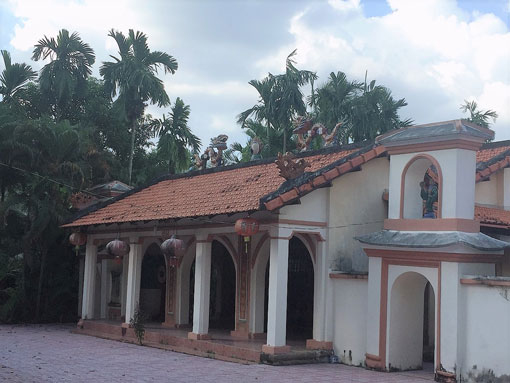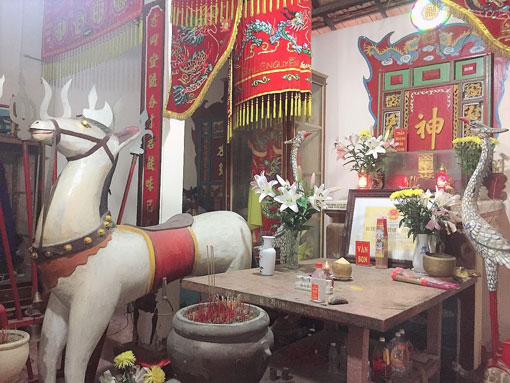A temple of historical values
An Son Temple is one of the temples approved as historical and cultural landmarks of the province. An Son Temple aged over a hundred of years. It was not only a symboly of culture and spirit but also a hideout of the armed force during the resistance wars.
Historical marks
Tracking the small paths within orchards of An Son commune, we was back to An Son Temple in a late afternoon of September. An Son Temple is located at An Quoi hamlet, An Son commune, Thuan An city. Led by an officer of An Quoi hamlet, we met the care-taker of An Son Temple who introduced us the history and culture embedded within the temple. Showing us around, the temple care-taker talked about his life and the assignment of taking care of the temple in over 40 years. He asserted that the temple is valuable in terms of culture, spirit and revolutionary history. An Son Temple is located within green orchards surrounded by complex dykes getting water for Saigon River which flows accross. Thus, a hideout was ideal at the site. From the beginning of the resistance war in Southern Region of Vietnam, An Son Temple had been chosen as a base for resistance of the then Thu Dau Mot and Gia Dinh.

A corner of today’s An Son Temple is visible

The chamber used for worshiping local god is within An Son Temple
As documented, An Son Temple in the stage of resistance war against the French colony was a base of the province under the name of An Son warbase. Located near Saigon, the temple was a stopover for resistance armed force of the South. An Son Temple in the time of resistance war against the US army became a frontline medical station where the armed force of Vietnam gathered to attack Saigon. An Son Temple is separated from Saigon only by a river but it has green orchards which were good cover and safe hideout for injured soldiers. Thanks to the help and protection of local people using secret underground hideouts near the temple, the armed force was well protected from raids of the enemy. To limit such help, the enemy banned the temple worshiping; however, by various ways, locals of An Son managed to supply food and medicine to those revolutionary forces hiding within the temple. Currently, the secret hideouts are still preserved at the temple as remains of historical values. The preservation and rennovation of the temple are funded by Thuan An city People’s Committee.
To promote value of a remain
An Son Temple was constructed in 1914. Like many other temples in Vietnam, An Son Temple was set up by locals to worship their local god who as they believed protected their village. They also set up an altar worshiping President Ho Chi Minh at the front. According to the care-taker, An Son Temple was at first built in simple architecture. By 1935, local villagers contributed to reconstruct the temple by lime bricks. In the time of resistance war against the US army, the temple was destructed by bombs and bullets and had been repaired many times. In 1989 – the year of reestablishment, the temple was redesigned and upgraded entirely to become a firm and neat temple to be preserved as today.
Binh Duong Provincial People’s Committee rated An Son Temple as a historical landmark of the province on July 4, 2005 for its historical and cultural values. Thuan An City Division of Culture and Information and local authorities have organized various activities to preserve, renew and promote the value of the temple. Dinh Van Hau, Deputy Chairman of An Son Commune People’s Committee affirmed the historical and cultural value of the temple. On yearly basis, Veteran Association and Youth’s Union of the commune often organize visit and unity festivals at the site. Thuan An City People’s Committee has also funded to upgrade, repair and rennovate sections of the temple. On monthly basis, the temple is sprayed with anti-moss and disinfectants.
“As a place of preserving cultural and spiritual values of local people, An Son Temple is also a place for educating patriotism to all generations of An Son people. For the time to come, we will organize more local activities in integration with historical value of the temple. By these activities, local people and younger generation will know more about history of the place and be proud of their fathers; thereon, more efforts will be made to construct a developed homeland,” said Hau.
Reported by Cam Ly – Translated by Vi Bao
 Two Vietnamese win S.E.A. Write Award
Two Vietnamese win S.E.A. Write Award
 Vietnam begin Asian Esports Games 2024 with win over Thailand
Vietnam begin Asian Esports Games 2024 with win over Thailand
 "Every throw is infused with my deepest hope"
"Every throw is infused with my deepest hope"
ITF U18 – J30 2024 Tournament wraps up in Ninh Binh
 Anniversary of Tan Khanh Ba Tra martial arts celebrated
Anniversary of Tan Khanh Ba Tra martial arts celebrated
 Binh Duong ready for Dong Nam Bo Judo Open Tournament 2024
Binh Duong ready for Dong Nam Bo Judo Open Tournament 2024
 Vietnam promotes cultural heritage values for sustainable future
Vietnam promotes cultural heritage values for sustainable future
Vietnamese culture promoted in Laos
 More than 10,000 runners to join Binh Phuoc Marathon
More than 10,000 runners to join Binh Phuoc Marathon
 More playgrounds created for the public
More playgrounds created for the public



